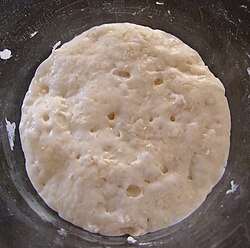This article needs additional citations for verification .(April 2021) |

Biga is a type of pre-fermentation used in Italian baking. Many popular Italian breads, including ciabatta, are made using a biga. [1] Using a biga adds complexity to the bread's flavor [2] [3] and is often used in breads that need a light, open texture with holes. Apart from adding to flavor and texture, a biga also helps to preserve bread by making it less perishable. [4] [5]
Contents
Biga techniques were developed after the advent of baker's yeast as bakers in Italy moved away from the use of sourdough and needed to recover some of the flavor that was given up in this move.[ citation needed ]
